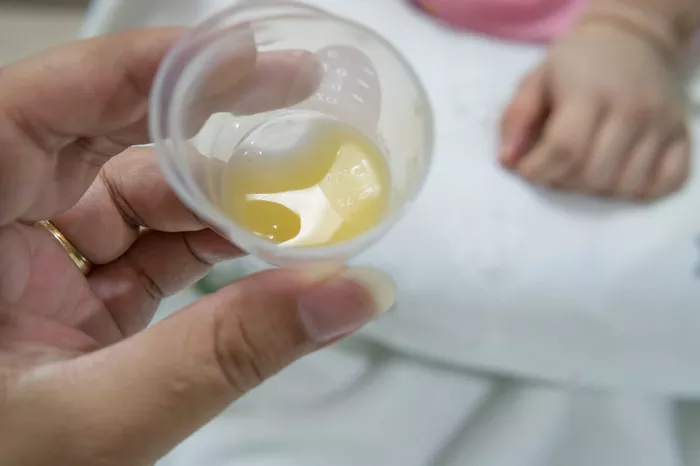Breastfeeding is an intimate and crucial aspect of early motherhood, providing essential nutrients and antibodies to newborns. Among the many components of breast milk, colostrum stands out as a vital elixir for newborns, packed with immune-boosting properties and essential nutrients. Hand expressing colostrum, the thick, yellowish precursor to breast milk, has gained recognition for its numerous benefits. In this article, we delve into what colostrum is, its potential benefits, when and how to harvest it, storage methods, and other considerations for maximizing its efficacy.
What is Colostrum?
Colostrum is the first milk produced by the mammary glands during late pregnancy and in the days immediately following childbirth. Often referred to as “liquid gold,” colostrum is rich in antibodies, proteins, vitamins, and minerals, essential for jumpstarting a newborn’s immune system and providing nourishment during the initial days of life. Unlike mature breast milk, colostrum is thick and concentrated, facilitating easy digestion for the newborn’s delicate digestive system.
What are the Potential Benefits of Hand Expressing Colostrum?
The benefits of hand expressing colostrum are manifold, offering advantages for both mothers and newborns. Some potential benefits include:
1. Immune System Boost: Colostrum is packed with antibodies and immunoglobulins, providing passive immunity to the newborn against a wide array of pathogens. This boost is particularly crucial during the vulnerable early days of life when the infant’s immune system is still developing.
2. Nutritional Richness: Despite its small volume, colostrum is densely packed with essential nutrients such as protein, fat-soluble vitamins, and minerals, providing newborns with a concentrated source of nourishment.
3. Gastrointestinal Protection: Colostrum contains substances like secretory IgA that help coat the infant’s gastrointestinal tract, protecting it from harmful bacteria and viruses and promoting the growth of beneficial gut bacteria.
4. Stimulation of Milk Production: Hand expressing colostrum in the early postpartum period can help stimulate milk production and establish a robust breastfeeding relationship between the mother and infant.
5. Bonding and Comfort: The act of hand expressing colostrum allows mothers to bond with their newborns through skin-to-skin contact and provides a sense of comfort and empowerment in nurturing their babies.
When to Start Harvesting Your Colostrum
It’s recommended to start hand expressing colostrum in the late stages of pregnancy, typically around 37 weeks gestation. However, it’s crucial to consult with a healthcare provider or lactation consultant before initiating any expression to ensure it’s safe for both the mother and baby, especially in cases of high-risk pregnancies or medical conditions.
How to Harvest (Collect) Your Colostrum
Hand expressing colostrum is a simple yet effective technique that can be done by following these steps:
1. Prepare: Wash your hands thoroughly with soap and warm water to maintain hygiene. Find a comfortable and relaxing environment to minimize stress, as relaxation can enhance milk let-down.
2. Massage: Gently massage your breasts in a circular motion starting from the outer edges towards the nipple to stimulate milk production and encourage let-down.
3. Expression Technique: With your thumb and fingers forming a C-shape around the breast, gently compress the breast tissue towards the chest wall, avoiding the areola to prevent discomfort.
4. Collect Colostrum: Position a clean container, preferably a sterile syringe or small cup, beneath the nipple to catch the expressed colostrum. Continue expressing from both breasts until the flow diminishes.
5. Storage: Transfer the collected colostrum into a clean, sterile container with a tight-fitting lid, ensuring proper labeling with the date and time of expression.
6. Clean Up: Cleanse the breasts and nipples with warm water and pat dry after expressing to prevent any bacterial growth.
How to Store Your Colostrum
Proper storage of colostrum is essential to maintain its nutritional and immunological properties. Follow these guidelines for safe storage:
1. Refrigeration: Freshly expressed colostrum can be stored in the refrigerator for up to 72 hours at temperatures between 32°F to 39°F (0°C to 4°C).
2. Freezing: For long-term storage, colostrum can be frozen in sterile containers or breast milk storage bags. It can remain viable for up to six months in a standard freezer (-4°F or -20°C) or up to 12 months in a deep freezer (-31°F or -35°C).
3. Thawing: When ready to use, thaw frozen colostrum by placing it in the refrigerator overnight or by gently warming it in a bowl of warm water. Avoid microwaving or heating colostrum directly, as it can destroy its beneficial properties.
4. Discard Unused Portions: Colostrum that has been thawed should not be refrozen and should be discarded if not used within 24 hours to prevent bacterial contamination.
Other Considerations for Harvesting Colostrum
In addition to the harvesting and storage process, consider the following factors:
1. Consultation with Healthcare Providers: Always consult with healthcare providers, including obstetricians, midwives, or lactation consultants, before initiating colostrum expression, especially in cases of high-risk pregnancies or medical conditions.
2. Frequency of Expression: While it’s generally safe to hand express colostrum, avoid overstimulation of the breasts to prevent premature labor or contractions, especially in women at risk for preterm birth.
3. Emotional Support: Hand expressing colostrum can be emotionally taxing for some mothers, especially those who have experienced challenges during pregnancy or childbirth. Seek emotional support from partners, family members, or support groups if needed.
4. Breastfeeding Support: Hand expressing colostrum is just the beginning of the breastfeeding journey. Seek support from lactation consultants or breastfeeding support groups to address any challenges and ensure a successful breastfeeding experience.
In conclusion, hand expressing colostrum offers numerous benefits for both mothers and newborns, providing essential nutrients, immune protection, and fostering bonding and breastfeeding success. By understanding the process of harvesting, storing, and utilizing colostrum effectively, mothers can optimize the health and well-being of their newborns in the critical early days of life.


